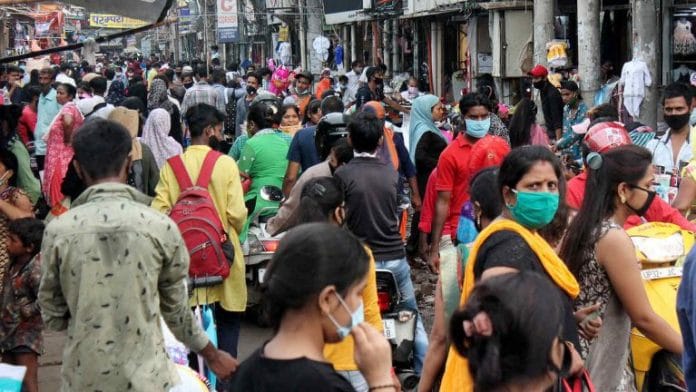New Delhi: A majority of adults (98.4 per cent) in India consume an inadequate amount of fruits and vegetables, and one in every five people are overweight, the National Non-Communicable Disease Monitoring Survey (NNMS), 2017-2018, released Monday noted.
The report was released by Health Minister Harsh Vardhan during the decadal year celebrations of ICMR’s National Center For Disease Informatics & Research that had conducted the survey.
Carried out between 2017 and 2018, the survey included responses from 10,659 adults (18-69 years) and 1,402 adolescents (15-17 years).
Among other findings, the survey also found that 41.3 per cent of adults surveyed and 25.2 per cent of adolescents did not do sufficient physical activity.
In addition to this, nearly three out of 10 respondents (28.5 per cent) had raised blood pressure, especially “in urban areas and with increasing age”.
“The country is facing epidemiologic transition towards NCD (non-communicable diseases) and their occurrence in younger age groups among the poorer sections of the society remains a matter of concern demanding greater attention,” the health minister noted, in his message in the report.
Also read: Gout drug reduces Covid death or hospitalisation risk by 21%, say Canadian researchers
How the survey was conducted
The NNMS was a cross-sectional survey that covered 12,000 households — 6,000 urban and 6,000 rural. The survey looked at 21 indicators — 10 related to adults, three for adolescents, one at the household level and rest to study health system responses.
The sample population in the survey was chosen through a multistage cluster sampling method.
For instance, to choose rural households for the survey, geographically contiguous districts were stratified into regions. In each region, a sub-stratification was chosen based on the village population size and female literacy rate. As many as 300 villages were picked in each stratum, of which 20 households were then chosen.
Households were similarly chosen from census enumeration blocks of wards in urban areas. The Primary Sampling Units (PSUs) were then surveyed by a team.
Noteworthy findings
As many as 26.1 per cent of adult respondents were overweight and 6.2 per cent obese. These figures were especially higher among the urban populace and women. Among adolescent respondents, 6.2 per cent were overweight and 1.8 per cent obese.
The survey also noted 17.0 per cent respondents were in stage-1 hypertension and 7.9 per cent were in stage-2 hypertension. Around 9.3 per cent of the respondents had raised blood glucose — 14.4 per cent in urban areas and 6.9 per cent in rural.
About dietary habits, the survey found that “the mean serving of fruits and/or vegetables consumed in a day was 1.7”. The recommended number of servings of fruits and vegetables is at least five. For adolescents, it was found that 48.3 per cent had skipped breakfast on at least one day in the past 30 days.
“It was observed that only 10.5% of all adults were engaged in doing any form of voluntary physical activity (like sports, fitness etc.) during recreational time, urban 14.8% and rural 8.3%; men 17.2% and women 3.4%,” were the survey’s findings.
Meanwhile, 25.2 per cent adolescents did not meet the WHO recommended levels of physical activity.
The survey also found that 40.2 per cent of those aged 18-69 had at least three risk factors that included “daily tobacco use, inadequate fruits and/or vegetable intake, insufficient physical activity, overweight (≥25.0 Kg/m2), raised blood pressure, and raised fasting blood glucose including those on medication”.
Recommendations
The report listed out several recommendations, including the regularisation of such surveys.
Regarding the setting up of a national NCD surveillance department/unit, the survey said, “Primarily, this department/unit would periodically gather, analyse and report timely data for action and closely liaison with the stakeholders for interventions and actions.”
It also stressed that a national NCD research agenda has to be developed for at least 10 years “so as to guide research and funding priorities and stakeholder engagements to fill the knowledge and operational gaps as relevant to the policies and program requirements”.
Also read: Cancer cases needing surgery to rise by 5 million by 2040 globally — Lancet Oncology study






